The K2 Base Camp Trek is an epic and challenging trek to the base camp of the second highest mountain in the world!
This remote and rugged trek is considered one of the greatest hikes in the world as it takes you through the dramatic terrain of the Karakoram range with unparalleled views and incredible natural formations.
Below is a guide to all the most frequently asked questions about the K2 Base Camp Trek so that you can get all the information you need before embarking on your adventure!
Trekking To K2 Base Camp (12 FAQs)
When is the best time to hike the K2 Base Camp Trek?
The best time to hike to K2 Base Camp is between July and August. Although, the trekking season runs from mid-June to mid-September, so it is possible to trek anytime during those months.
It is not recommended to trek in early-June because the snow has not yet melted away. Thus, passes above 3,000 meters are closed until enough snow has melted away to enable hiking. Gondogoro La and many of the other passes will also close by the end of September due to the return of heavy snowfall as the seasons change.
See more on attempts at K2 Winter Ascents.
Important Consideration
If you choose to hike towards the end of the trekking season, you also run the risk of having to cross Gondogoro La without any additional support as the Mountain Rescue Support Team are only available up until early September.
What is the weather like on the K2 Base Camp Trek?
The weather you’ll experience on the trek depends on what time of year you choose to hike. July and August are the most popular trekking months. This is when the skies are more likely to be clear and the weather more stable.
While the weather during the trekking season is generally quite good, hikers should always be prepared for anything as mountain conditions can be very unpredictable - especially in the higher reaches. You can expect strong winds, rain and snow as you hike. But hopefully you’ll experience mostly clear skies.
Temperatures on the mountain range from below freezing at night to quite warm during the day. So it is advisable that you pack multiple layers of clothing that you can easily put on and remove as the temperatures change.
The higher you trek, the colder it gets. Temperatures also get significantly colder as you reach the glacier so make sure you pack the right clothes to keep you warm.
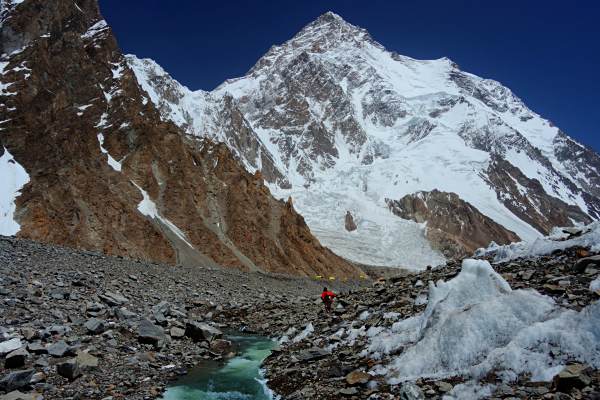
Photo by Zacharie Grossen
How long is the K2 Base Camp Trek?
Most itineraries for the K2 Base Camp Trek are between 21 and 25 days long. Though the number of days you will actually be trekking to the base camp is about 14 (weather permitting).
The long itineraries generally include meeting with your hiking group and guide, sightseeing in Islamabad and Skardu, travel to the starting point at Askole, making the trek and travelling back to Islamabad. Many itineraries also include one or two extra days in case of bad weather that may cause delays or prevent trekking.
How difficult is the K2 Base Camp Trek?
The K2 Base Camp trek is long and strenuous. You should have a good level of fitness and be in good health if you are planning to take on the challenge.
There isn’t a proper trail on the Baltoro Glacier, which you’ll be trekking on for a couple of days, so it is quite slow going and difficult at times due to loose scree. If your trip includes crossing the Gondogoro La, you will need to know how to use crampons and an ice axe.
It is recommended that you have done some winter hiking in snow and at high altitude before taking on this trek.
Can I trek to K2 Base Camp independently?
You cannot hike the K2 Base Camp Trek independently. All travelers must be accompanied by a licensed guide.
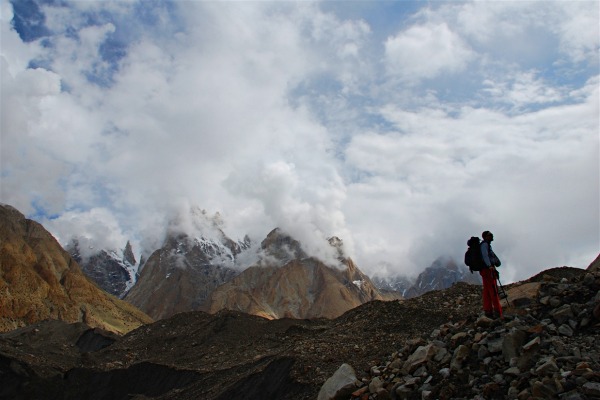
Photo by Stefanos Nikologianis
How much does the K2 Base Camp Trek cost?
The cost of the K2 Base Camp Trek varies depending on the tour operator you choose and the length of the trip you book for.
Below is a breakdown of the trek costs according to budget, mid-level and luxury options.
Budget
You can find budget tour operators offering the K2 Base Camp Trek for about $1500 - $2300. We don’t recommend booking through these tour operators unless you absolutely have to. The lower cost means less food and very basic amenities.
Mid-Level
Mid-level tour operators will cost you between $2500 and $3500. You can expect a good trek with added comforts of chairs, tables, good tents, quality meals and a generator to keep everything charged.
The tour operator should offer visa support and communicate all necessary information to you before your trek. You will also likely have a western guide accompanying the local Balti guides.
Mid-level tour operators offer everything you need for the K2 Base Camp Trek and are worth spending the extra few hundred bucks on.
Luxury
Luxury tour operators offer the most comfortable and well-planned treks to K2 Base Camp with several western guides, comfortable camping furniture, air mattresses and plenty of food. However, all these extra luxuries come at a cost as these treks could cost you anywhere between $3500 and $5000. These operators cater to the smaller, older crowd who can afford the extra costs.
What gear do I need for the K2 Base Camp Trek?
Gear that you need for the K2 Base Camp Trek can be split up into essentials, equipment, clothing and other accessories.
See more in our essential hiking gear list for multi-day treks.
Essentials
Duffel bag
First and foremost, you will need a good quality duffel bag to keep all your clothing, boots, sleeping bag and climbing gear organized. This bag should have a capacity of about 80L but if you have a large sleeping bag, then consider getting a bigger expedition bag. We recommend The North Face Base Camp Duffel.
Daypack
During the trek, you will hike with your daypack, so it should be big enough to fit all of your essentials in. We recommend getting a daypack with a capacity between 30L and 45L. This pack will be used to carry snacks, water, a rain jacket, extra clothing layers, sunblock, your camera and your passport. The Osprey Talon 33 is a great daypack choice.
Hiking boots and Alpine boots
Your hiking boots are one of the most important items on your trek so it is essential that you get a good quality pair and break them in before you embark on the K2 Base Camp Trek. For the higher sections of the trek, you will need a good pair of alpine boots. Especially if you’re crossing the Gondogoro La, as you will need to use crampons.
Sleeping Bag
It is vital to have a good quality 4-season sleeping bag so that you don’t freeze at night. A nice, warm sleeping bag will make your nights much easier as you’ll be able to sleep better in addition to being warm and comfortable. We recommend the Outdoor Vitals Summit 0 Degree Sleeping Bag.
Sleeping Pad
Tour operators should provide a sleeping pad for you, but it will most likely be a very thin, foam mat. Unless you’ve booked a luxury trek, we recommend bringing your own if you have one so that your nights will be more comfortable.
Equipment
Crampons
We highly recommend using crampons on the K2 Base Camp Trek, especially if you are planning on tackling Gondogoro La. However, if you are trekking in August, you will not need them as the ice would have melted away.
Microspikes
Microspikes, like the Kahtoola MICROspikes Traction System, are cheaper than crampons and are also a suitable option for trekking on ice.
Helmet
If you are crossing Gondogoro La, we recommend wearing a helmet as there is a high risk of rockfall. Melting ice can cause rocks to become loose and if one happened to fall one you it could be fatal. So better to be safe than sorry.
Harness and locking carabiner
Another item you’ll need if you’re taking on Gondogoro La is a harness so that you can clip yourself onto the fixed rope to prevent falls. The Black Diamond Momentum Harness is a top harness choice.
Trekking poles
Trekking poles can come in handy on the K2 Base Camp Trek as the mountainous terrain is very rugged and uneven. Trekking poles will help you keep your balance as you trek and take some pressure off your knees. We recommend the Black Diamond Alpine Carbon Cork trekking poles.
Clothing
- Down jacket
- Hard shell rain jacket
- Fleece top
- Base layer top
- Trekking shirts
- Base layer bottoms
- Lightweight hiking pants
- Hard shell trousers
- Sun hat and beanie
- Buff or balaclava
- Gloves
- Trekking socks (avoid cotton!)
- Synthetic underwear
Accessories/Other essential items
- Gaiters
- Headlamp
- Water purification tablets or water filter bottle (like the GRAYL Geopress Water Purifier Bottle)
- Dry bags
- Power bank
- Camera
- First Aid Kit
- A book to read
- Satellite messenger device
- Sunblock
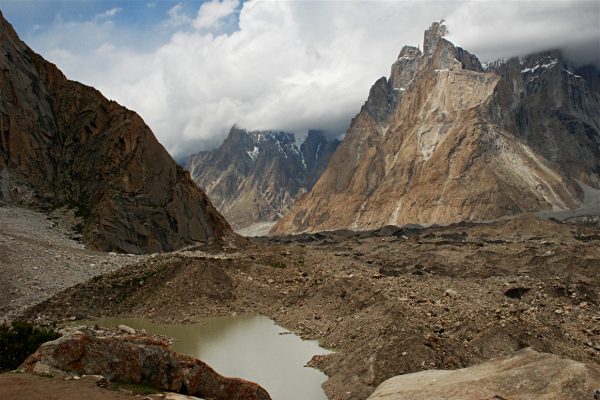
Photo by Stefanos Nikologianis
Is the K2 Base Camp Trek dangerous?
As with any high-altitude trek, there are some risks when hiking to the K2 Base Camp. The camp lies at about 5,400 meters so make sure you take enough time to acclimatize during your ascent to ensure you don’t suffer the effects of altitude sickness.
When walking on the glacier and the icy terrain, take your time so that you don’t slip and sprain your ankle. There is also the danger of rockfalls when crossing Gondogoro La so wearing a helmet is highly recommended.
Which route should I take for the K2 Base Camp Trek?
There are a few different routes that tour operators offer for the K2 Base Camp Trek, although most follow the easiet route that starts and finishes at Askole (avoiding Gondogoro La). This route is the most popular because it doesn’t require technical skills and offers some variability as you can decide to take a detour to the Trango Towers Base Camp or stay overnight at the Broad Peak Base Camp.
If you do want to tackle Gondogoro La, it is still recommended to start at Askole as it allows for better acclimatization. This route requires some technical skill when you cross the high mountain pass. The trail then descends the other side and follow the valley until you reach the village of Hushe.
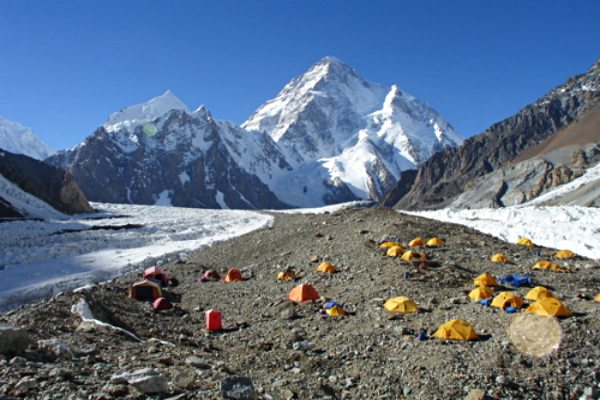
Photo by Johncanivley
Is it safe to travel to Pakistan?
The British Foreign and Commonwealth Office (FCO) have changed their recommendations regarding travelling to Pakistan for trekking purposes by removing their advice to avoid all but necessary travel for Skardu and Gilgit. However, they still advise against travelling on the Karakoram Highway.
It is considered safe to travel within the trekking region. You can find out more about security in Pakistan from the FCO’s website.
Do I need travel insurance for the K2 Base Camp Trek?
You do need travel insurance if you are planning on hiking the K2 Base Camp Trek. Make sure you get a plan that covers any medical emergencies, repatriation and emergency helicopter rescue. You should have a minimum coverage of $200,000 and ensure that the policy covers mountaineering and high altitude trekking up to 5,600 meters.
See more in our guide on the best hiking insurance.
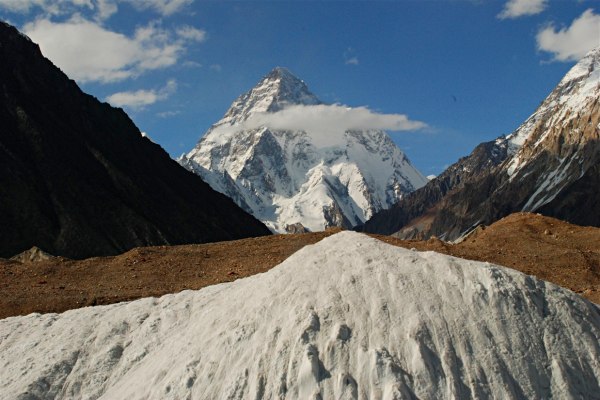
Photo by Stefanos Nikologianis
K2 Base Camp Trek vs Everest Base Camp Trek - which is the better trek?
Wondering whether you should hike to K2 Base Camp or Everest Base Camp (EBC)? Here are some of the main differences between the two iconic treks to help you decide which one is right for you.
The Everest Base Camp Trek sees tens of thousands of trekkers every year. Its popularity means that the routes are very well maintained and difficult to miss. Due to safety concerns regarding travelling in Pakistan, the K2 Base Camp Trek sees far fewer people and has only quite recently become more of a consideration for avid hikers.
This also means that the K2 Base Camp Trek is much quieter and less crowded than the EBC trek. So if you want a more remote and isolated adventure, then K2 Base Camp is the trek for you. You get pristine views of the 8000ers around you from the K2 Base Camp Trek and witness the incredible convergence of glacier and rock at Concordia.
The scenery along the EBC trek is also very different and varies from forests and rivers to icy rocks and alpine terrain. Meanwhile, the K2 Base Camp trek is quite dry and dusty before ascending into the rocky mountains icy glaciers.
Despite being similar in elevation, the two treks are completely different and you should choose the one you think you’ll get the most out of. Maybe you’ll even have the opportunity to do both one day!
Continue browsing...
See more information on Asia. Or check out these other Asian Hiking articles:
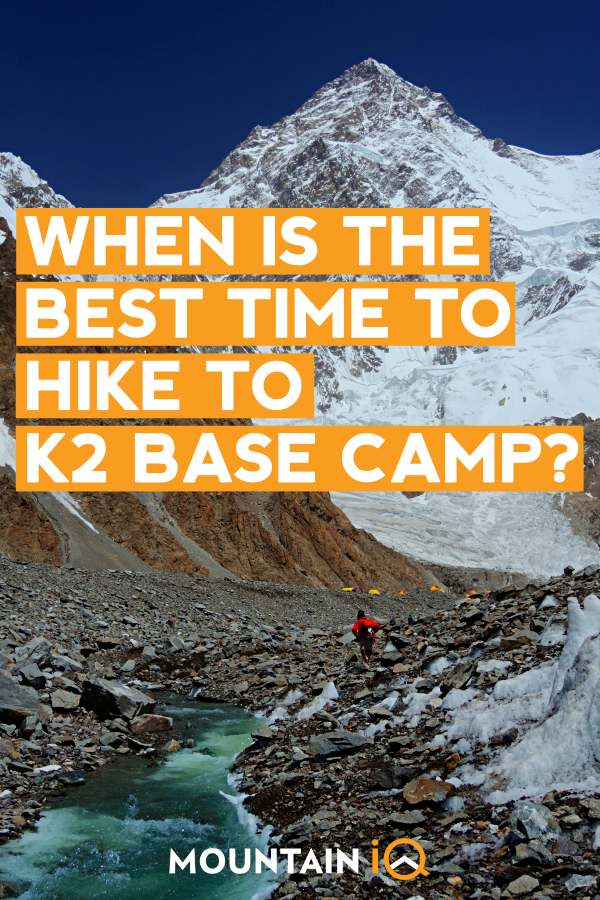

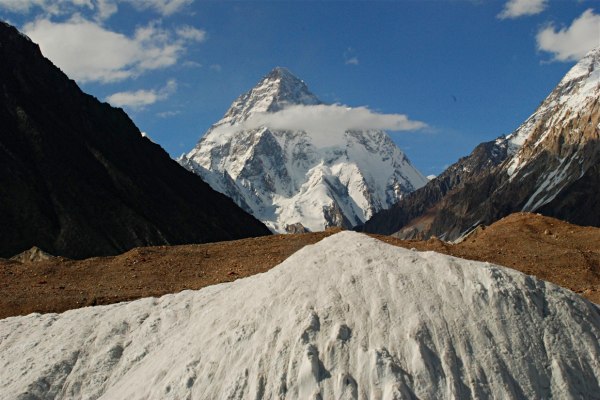
Thank you for such detailed and informative content. This is really helpful for us. Thank You. Keep it Up.
I have a question which can only be answered by people who have been to the base camp, so after Askole, you walk along side a river to Concordia, and you hardly walk on ice. And the river valley is quite wide too. So if someone has a special off-road jeep why don’t they just drive along the river to base camp instead of walking?
Very helpful and informative. Thank you. People like you are priceless